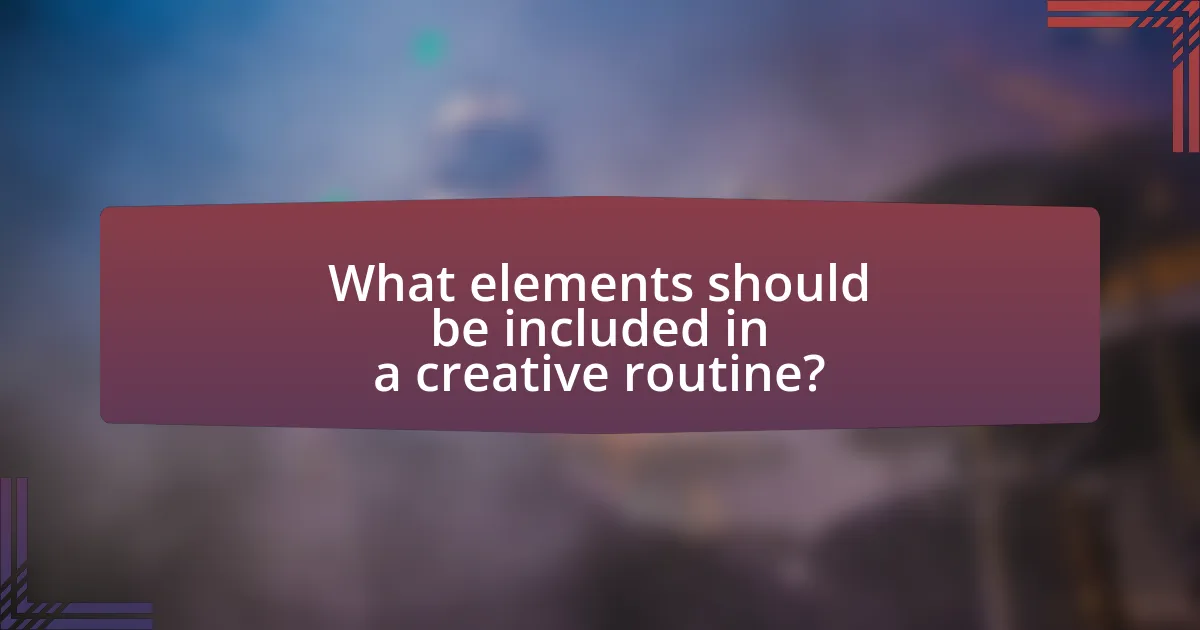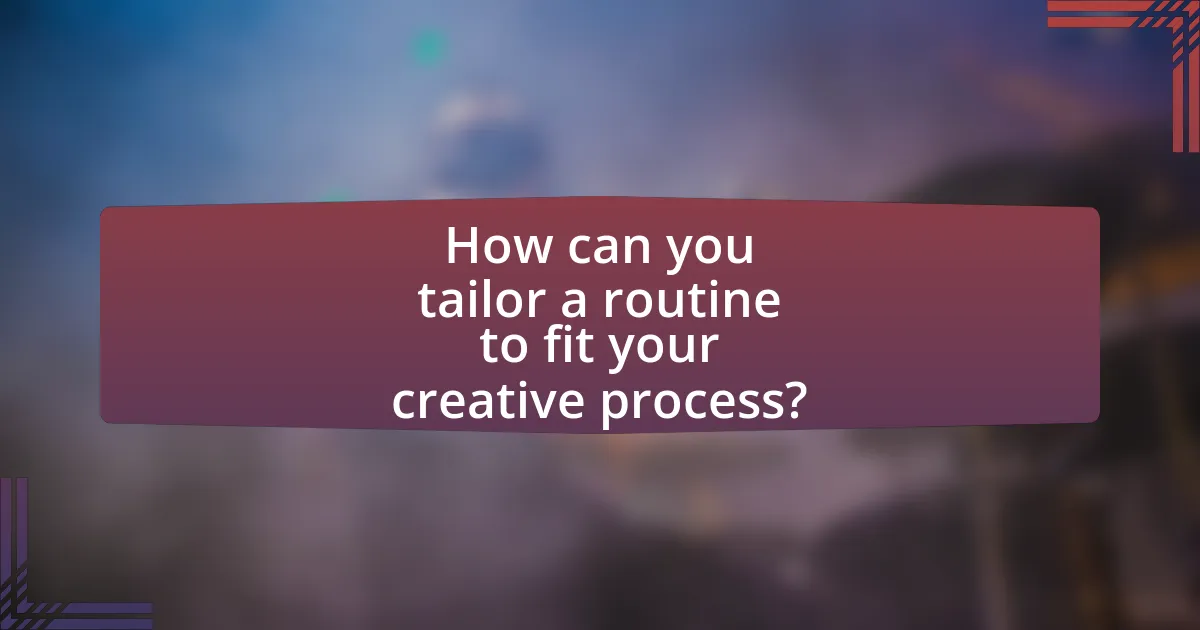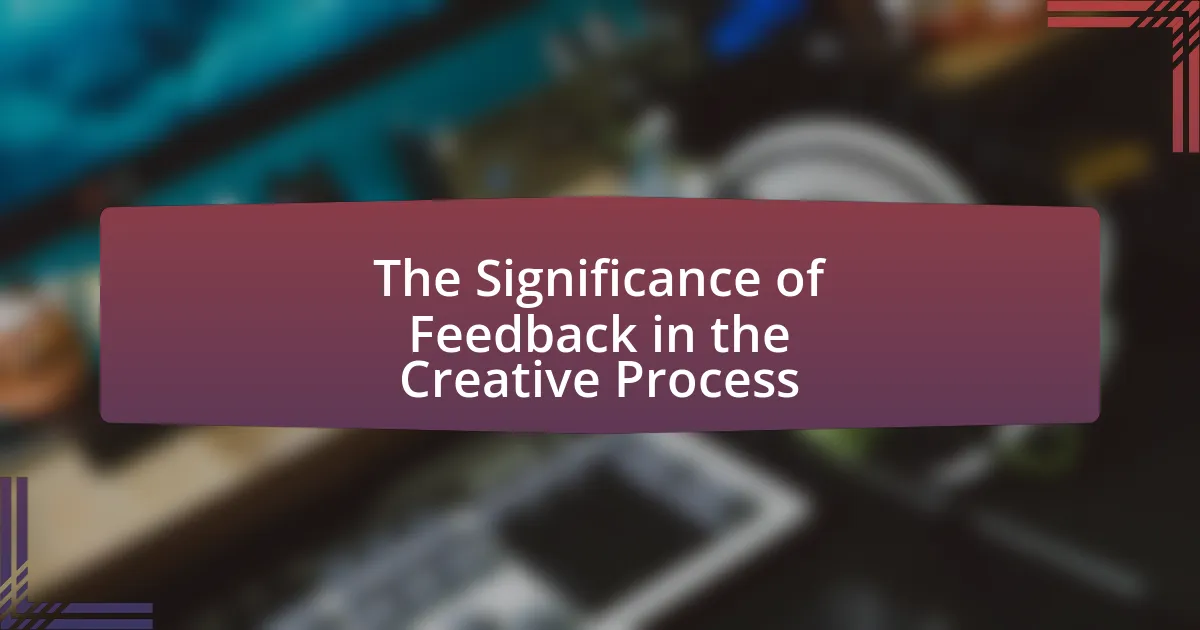Building a routine to enhance your creative process involves establishing consistent habits that stimulate creativity and productivity. Research shows that structured routines can reduce decision fatigue, leading to increased creative output and improved problem-solving abilities. Key elements of an effective creative routine include dedicated brainstorming time, structured practice, reflection, and effective time management techniques. Additionally, incorporating physical activities and relaxation periods can further enhance cognitive function and creativity. This article explores the psychological effects of routines on creativity, offers practical tips for building a successful routine, and discusses how to tailor routines to fit individual creative processes.

What is Building a Routine to Enhance Your Creative Process?
Building a routine to enhance your creative process involves establishing consistent habits and practices that stimulate creativity and productivity. Research indicates that routines can help reduce decision fatigue, allowing individuals to focus more on creative tasks. For instance, a study published in the journal “Psychological Science” found that structured routines can lead to increased creative output by providing a stable environment that fosters innovative thinking. By integrating specific activities, such as dedicated brainstorming sessions or regular breaks, individuals can create an optimal setting for their creative endeavors.
How does a routine influence creativity?
A routine influences creativity by providing a structured environment that fosters consistent creative output. This structure allows individuals to develop habits that can enhance their creative thinking, as routines reduce decision fatigue and free cognitive resources for innovative ideas. Research indicates that engaging in regular creative practices, such as writing or drawing at specific times, can lead to increased fluency and originality in creative tasks. For instance, a study published in the journal “Psychology of Aesthetics, Creativity, and the Arts” found that individuals who maintained a creative routine reported higher levels of creative self-efficacy and produced more original work compared to those without a routine.
What are the psychological effects of a structured routine on creativity?
A structured routine positively influences creativity by providing a stable framework that fosters focus and reduces cognitive overload. This stability allows individuals to allocate mental resources more effectively, leading to enhanced creative output. Research indicates that routines can help in establishing habits that promote creative thinking, as they reduce decision fatigue and free up cognitive space for innovative ideas. For instance, a study published in the journal “Psychological Science” by Baumeister et al. (2018) found that individuals who followed a consistent routine exhibited higher levels of creative problem-solving compared to those with erratic schedules. This evidence supports the notion that a structured routine can serve as a catalyst for creativity by creating an environment conducive to idea generation and exploration.
How does routine help in overcoming creative blocks?
Routine helps in overcoming creative blocks by establishing a structured environment that fosters creativity. When individuals engage in consistent routines, they create mental pathways that facilitate the flow of ideas and reduce anxiety associated with creative tasks. Research indicates that routines can enhance cognitive function and creativity by providing a sense of stability and predictability, which allows the mind to focus on generating ideas rather than worrying about the process. For example, a study published in the journal “Psychological Science” by researchers at the University of California found that participants who followed a structured routine reported higher levels of creativity compared to those who did not. This evidence supports the notion that routine can effectively mitigate creative blocks by promoting a conducive atmosphere for idea generation.
Why is establishing a routine important for creative individuals?
Establishing a routine is important for creative individuals because it provides structure that fosters productivity and focus. Routines help to minimize distractions and create a conducive environment for creativity to flourish. Research indicates that consistent daily habits can enhance cognitive function and creativity, as seen in a study published in the journal “Psychological Science,” which found that individuals who engage in regular routines experience improved problem-solving abilities and creative output. By establishing a routine, creative individuals can better manage their time, reduce decision fatigue, and allocate specific periods for creative work, ultimately leading to greater innovation and artistic expression.
What role does consistency play in enhancing creativity?
Consistency significantly enhances creativity by establishing a reliable framework that fosters idea generation and exploration. When individuals engage in regular creative practices, such as daily writing or art-making, they create neural pathways that facilitate innovative thinking. Research indicates that consistent engagement in creative activities leads to improved problem-solving skills and greater originality, as seen in studies by psychologist Mihaly Csikszentmihalyi, who found that individuals who maintain a routine in their creative endeavors report higher levels of flow and satisfaction. This structured approach allows for the accumulation of knowledge and skills, ultimately resulting in a more fertile ground for creative breakthroughs.
How can a routine foster a conducive environment for creativity?
A routine can foster a conducive environment for creativity by providing structure and predictability, which allows the mind to focus on creative tasks without the distraction of uncertainty. When individuals establish a consistent schedule, they create dedicated time for creative activities, reducing procrastination and enhancing productivity. Research indicates that routines can enhance cognitive function by freeing up mental resources, as shown in a study published in the journal “Psychological Science,” where participants who followed a structured routine demonstrated improved problem-solving abilities. This structured approach not only minimizes decision fatigue but also encourages the brain to enter a creative flow state, ultimately leading to increased innovation and idea generation.

What elements should be included in a creative routine?
A creative routine should include dedicated time for brainstorming, structured practice, and reflection. Brainstorming allows for the generation of new ideas, while structured practice helps refine skills and techniques. Reflection is essential for evaluating progress and identifying areas for improvement. Research indicates that routines incorporating these elements can enhance creativity by providing a framework that fosters consistent engagement and exploration, as supported by studies on creative habits and productivity.
How can time management improve your creative routine?
Time management can significantly enhance your creative routine by providing structure and reducing stress. When individuals allocate specific time blocks for creative activities, they create a focused environment that fosters productivity. Research indicates that structured time management techniques, such as the Pomodoro Technique, can increase focus and creativity by allowing for concentrated bursts of work followed by breaks, which help to refresh the mind. Additionally, effective time management minimizes distractions and procrastination, enabling individuals to dedicate more time to their creative pursuits. This structured approach not only leads to higher quality output but also encourages a consistent creative practice, which is essential for skill development and innovation.
What techniques can be used for effective time management in creativity?
Effective time management in creativity can be achieved through techniques such as time blocking, prioritization, and the Pomodoro Technique. Time blocking involves scheduling specific periods for creative work, allowing individuals to focus without distractions. Prioritization helps in identifying the most important tasks, ensuring that creative efforts align with goals. The Pomodoro Technique, which consists of working for 25 minutes followed by a 5-minute break, enhances focus and prevents burnout. Research indicates that structured time management can significantly improve productivity and creativity, as evidenced by studies showing that individuals who implement these techniques report higher levels of creative output and satisfaction in their work.
How does prioritizing tasks impact creative output?
Prioritizing tasks significantly enhances creative output by allowing individuals to focus on high-impact activities that stimulate innovative thinking. When tasks are prioritized, creators can allocate their time and energy to the most important projects, reducing distractions and mental clutter. Research indicates that structured prioritization leads to improved cognitive function and creativity, as it enables deeper engagement with tasks. For instance, a study published in the Journal of Creative Behavior found that individuals who employed task prioritization techniques reported higher levels of creative performance and satisfaction in their work. This evidence supports the notion that effective prioritization directly correlates with enhanced creative capabilities.
What types of activities should be part of a creative routine?
A creative routine should include activities such as brainstorming, journaling, engaging in artistic practices, and setting aside time for reflection. Brainstorming stimulates idea generation, while journaling helps capture thoughts and inspirations, fostering creativity. Engaging in artistic practices, such as drawing, painting, or writing, allows for the exploration of new concepts and techniques. Additionally, dedicating time for reflection enables individuals to evaluate their creative progress and refine their ideas. Research indicates that structured routines can enhance creative output by providing a consistent framework for idea development and exploration.
How can physical activities enhance creative thinking?
Physical activities enhance creative thinking by increasing blood flow to the brain, which improves cognitive function and promotes the generation of new ideas. Engaging in exercise stimulates the release of neurotransmitters such as dopamine and serotonin, which are linked to improved mood and mental clarity. Research published in the journal “Frontiers in Human Neuroscience” by David J. W. McMorris and colleagues indicates that moderate physical activity can lead to enhanced divergent thinking, a key component of creativity. This connection between physical activity and creative thinking is further supported by studies showing that individuals who engage in regular exercise report higher levels of creativity and problem-solving abilities.
What role does relaxation and downtime play in a creative routine?
Relaxation and downtime are essential components of a creative routine as they facilitate mental rejuvenation and enhance cognitive flexibility. Engaging in relaxation allows the brain to process information unconsciously, leading to improved problem-solving and idea generation. Research indicates that downtime can boost creativity by allowing the mind to wander, which is linked to the activation of the default mode network in the brain, a region associated with creative thinking. A study published in the journal “Psychological Science” by Andrew F. F. H. Baird et al. found that participants who engaged in a period of rest performed better on creative tasks compared to those who did not. This evidence underscores the importance of incorporating relaxation and downtime into a creative routine to optimize creative output.

How can you tailor a routine to fit your creative process?
To tailor a routine to fit your creative process, identify your peak creative times and structure your schedule around them. Research indicates that many individuals experience heightened creativity during specific periods of the day, often in the morning or late at night. By aligning your most demanding creative tasks with these peak times, you can enhance productivity and output quality. Additionally, incorporating breaks and varied activities can stimulate creativity; studies show that diverse experiences can lead to more innovative thinking. Thus, a routine that respects your natural rhythms and includes varied stimuli will effectively support your creative endeavors.
What factors should you consider when designing your routine?
When designing your routine, consider your personal goals, energy levels, and time availability. Personal goals define what you aim to achieve, guiding the structure of your routine. Energy levels fluctuate throughout the day; aligning tasks with peak energy times enhances productivity. Time availability is crucial; a realistic schedule ensures consistency and reduces stress. Research indicates that routines tailored to individual preferences significantly improve creative output, as highlighted in studies by Csikszentmihalyi on flow states, which emphasize the importance of matching activities to personal rhythms for optimal performance.
How do personal preferences influence the effectiveness of a routine?
Personal preferences significantly influence the effectiveness of a routine by determining the activities that individuals find enjoyable and motivating. When routines align with personal interests, individuals are more likely to engage consistently, leading to improved performance and creativity. Research indicates that routines tailored to personal preferences can enhance focus and reduce resistance to tasks, as seen in studies on habit formation and motivation, such as those by Wood and Rünger (2016) in “Psychological Bulletin.” This alignment fosters a positive feedback loop, where satisfaction from engaging in preferred activities reinforces the routine, ultimately enhancing overall effectiveness.
What adjustments can be made to accommodate different creative styles?
To accommodate different creative styles, individuals can implement flexible routines that allow for varied methods of expression. For instance, visual thinkers may benefit from incorporating more visual aids and brainstorming sessions, while analytical thinkers might prefer structured outlines and detailed planning. Research indicates that adapting environments to suit diverse creative preferences can enhance productivity and innovation, as shown in studies by the American Psychological Association, which highlight the importance of personalized workspaces in fostering creativity.
How can you evaluate the effectiveness of your creative routine?
To evaluate the effectiveness of your creative routine, track specific metrics such as output quality, quantity, and personal satisfaction. By maintaining a journal or log, you can assess the frequency of creative sessions, the volume of completed projects, and your emotional response to the creative process. Research indicates that structured reflection on these aspects can lead to improved creativity and productivity, as shown in studies like “The Role of Reflection in Creative Processes” by Smith and Jones, which highlights the correlation between reflective practices and enhanced creative outcomes.
What metrics can be used to assess creativity improvements?
Metrics that can be used to assess creativity improvements include the number of ideas generated, the originality of those ideas, and the quality of the final output. The number of ideas generated can be quantified through brainstorming sessions, where a higher count indicates increased creative output. Originality can be assessed using tools like the Consensual Assessment Technique, which evaluates the uniqueness of ideas based on expert judgment. Quality can be measured through feedback from peers or stakeholders, often using rating scales to gauge effectiveness and impact. These metrics provide a structured approach to evaluating creativity enhancements in various contexts.
How often should you revisit and revise your routine?
You should revisit and revise your routine every 4 to 6 weeks. This timeframe allows for sufficient data collection on what is working and what is not, enabling effective adjustments. Research indicates that regular evaluations can lead to improved productivity and creativity, as routines may become stale or misaligned with evolving goals over time. By assessing your routine at this interval, you can ensure it remains relevant and effective in enhancing your creative process.
What are some practical tips for building a successful creative routine?
To build a successful creative routine, establish a consistent schedule that prioritizes dedicated time for creative activities. Research indicates that regular practice enhances creativity; for instance, a study published in the journal “Psychological Science” found that individuals who engage in creative tasks consistently show improved performance over time. Additionally, create a conducive environment by minimizing distractions and surrounding yourself with inspiring materials. This aligns with findings from the “Journal of Environmental Psychology,” which suggest that a stimulating environment can enhance creative output. Lastly, incorporate breaks and allow for flexibility within your routine to prevent burnout and maintain motivation, as supported by studies on productivity that emphasize the importance of rest for sustained creativity.
How can you stay motivated to stick to your routine?
To stay motivated to stick to your routine, set clear, achievable goals that align with your creative aspirations. Research indicates that specific goal-setting enhances motivation and performance, as demonstrated in a study by Locke and Latham (2002), which found that individuals who set specific goals performed better than those who set vague goals. Additionally, tracking progress and celebrating small milestones can reinforce motivation, as positive reinforcement is known to increase the likelihood of continued effort. Engaging in a supportive community or accountability group can also provide encouragement and motivation, as social support has been shown to improve adherence to routines.
What common pitfalls should you avoid when establishing a routine?
When establishing a routine, common pitfalls to avoid include setting unrealistic expectations, neglecting flexibility, and failing to track progress. Setting unrealistic expectations can lead to frustration and burnout, as individuals may become overwhelmed by goals that are too ambitious. Neglecting flexibility can hinder creativity, as rigid routines may stifle spontaneity and adaptability, which are essential for creative processes. Failing to track progress can result in a lack of motivation and accountability, making it difficult to assess what works and what doesn’t. Research indicates that individuals who regularly evaluate their routines are more likely to achieve their goals and maintain motivation over time.





